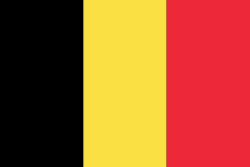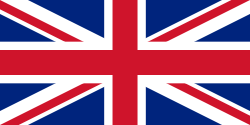Hello everyone, it’s Leïla here to shed some light on the subject of textile certifications for our products.
In a world where “eco,” “organic,” and “green” labels are popping up everywhere — even on textiles that have nothing sustainable about them — understanding the real certifications has become essential. Here’s a short guide to help you navigate, make conscious choices, and avoid falling into the trap of greenwashing.
If you’re curious about the warning signs to spot greenwashing, check out this article I wrote on the subject.
Key Takeaways
- Not all labels are equal: GOTS, GRS, and Fair Wear are the most comprehensive.
- OEKO-TEX says nothing about social or ecological conditions.
- BCI relies on an opaque “mass balance” system — useful but misleading if misinterpreted.
- Certifications = traceability + quality + ethics.
- A certified textile means less water, less CO₂, and more respect for people.
Textile certifications: what are they?
The main ecological (and social) standards
Ecological standards are defined by certain benchmarks and help set strict frameworks to limit environmental impact at all stages of production. This can include:
- banning pesticides or heavy metals,
- reduced water consumption,
- non-toxic dyeing processes,
- wastewater treatment,
- and social criteria: decent working conditions, fair wages, prohibition of child labor, workplace safety…
Some certifications also cover logistics, packaging, or factory energy consumption. In short, a good label looks at the entire life cycle of the product — humans included.
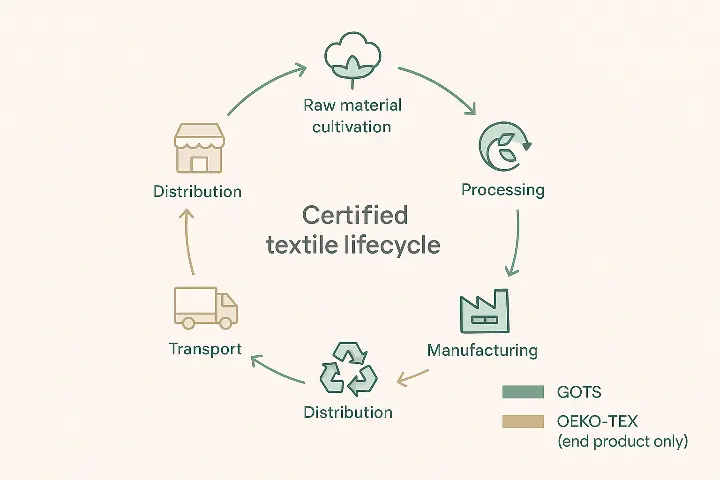
The sustainable labels to know
There are many labels, but not all are equal. Here are the ones we consider reliable, as they take into account ecology, social ethics, and traceability:
GOTS: Global Organic Textile Standard
The benchmark label for organic textiles. It guarantees:
- a minimum of 70% organic fibers (up to 95% for the “organic” mention),
- environmentally-friendly processing methods,
- compliance with strict social standards (no child labor, fair wages, safety…).
Specialized in recycled materials, this label ensures:
- a minimum content of recycled fibers,
- controlled social and environmental practices,
- complete traceability of the production chain.
This is not a product label, but a corporate commitment. Member brands agree to:
- actively improve working conditions in factories,
- follow an audit and corrective program,
- publish annual performance reports.
EcoVadis is a CSR assessment platform that rates companies on their environmental, social, ethical, and responsible purchasing commitments. It’s a B2B tool that helps select reliable partners based on concrete standards. At INKOO, a good EcoVadis score is a true trust indicator — especially when choosing our suppliers or partner workshops.
What these labels guarantee:
- Genuine traceability of the textile,
- Strict social standards,
- Reduced environmental impact at every stage.
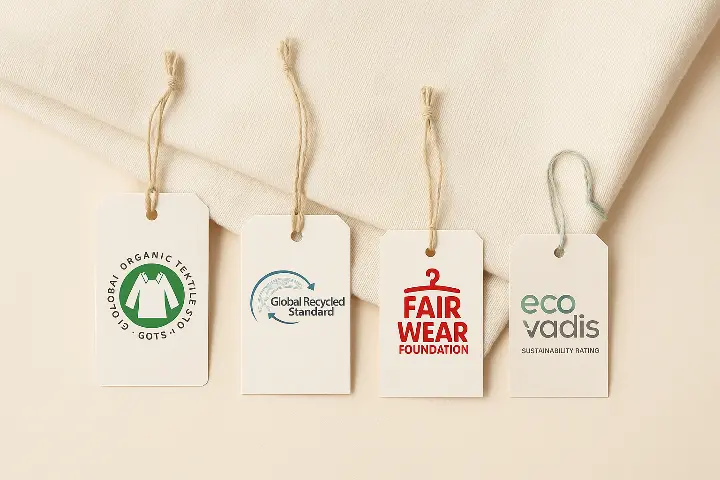
Labels to know… but to decode carefully
Some labels aren’t fake, but they’re often misinterpreted. They have the merit of existing, but don’t guarantee ecological manufacturing or ethical social conditions.
This label guarantees that no harmful substances (heavy metals, endocrine disruptors, etc.) are present in the finished product. It’s useful for garments worn directly against the skin, especially for babies or sensitive individuals.
⚠ But beware: OEKO-TEX says nothing about fiber origin, chemical processes used, or workers’ daily lives. A OEKO-TEX t-shirt can still come from a polluting or exploitative factory.
At INKOO, we use it as a complement, never as the sole reference.
BCI aims to improve cotton farming practices. It guarantees:
- Training for farmers in better agricultural practices (reduced pesticides, water savings, crop rotation, etc.)
- A goal of continuous improvement rather than strict requirements.
- A mass-balance system — BCI cotton can be mixed with conventional cotton.
What is mass balance? In short: they can produce 100 kg of certified cotton, mix it with 900 kg of conventional cotton, and still sell 100 kg of t-shirts as “BCI.” It’s not transparent, it fosters confusion. The idea is to gradually introduce responsible cotton into supply chains — a good intention, but not traceable and it doesn’t guarantee the final product contains sustainable cotton.
Main criticisms of BCI:
- Low transparency — BCI cotton is not 100% traceable back to the farm, unlike GOTS. The mass-balance system means a product labeled “BCI” may not actually contain responsible cotton.
- Environmental limits — BCI does not ban GMOs, allows some pesticides, and does not require organic fibers.
- Weak social criteria — although they mention “decent working conditions,” audits are often insufficient, and documented human rights violations have been reported in BCI areas, including Brazil.
So BCI aims to improve cotton farming on a large scale. It’s an interesting approach that has the merit of existing, but as it guarantees neither clear fiber origin tracking nor strict environmental and social criteria, it’s a label that sparks debate.
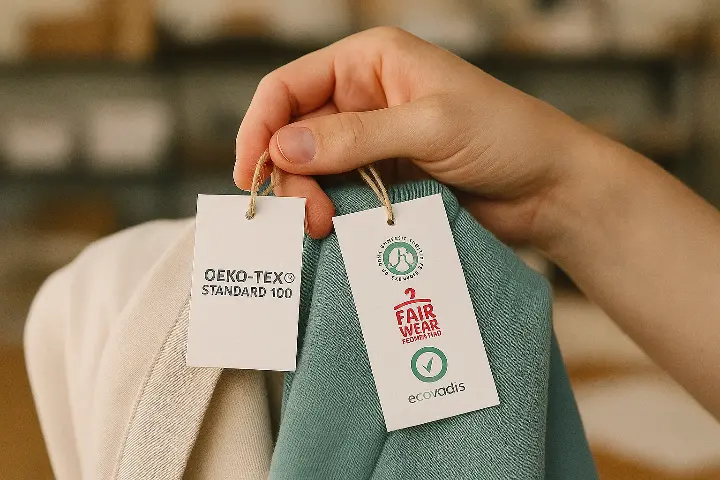
Source:
Earthsight (2024) Complacency and data manipulation at Better Cotton. Available here. (Accessed: 4 August 2025).
The importance of traceability in the textile industry
Guaranteeing fabric quality
Raw materials are crucial when choosing a textile to customize. A good textile isn’t just about style. The raw material plays a key role in durability: organic cotton will last longer, wash better, and give a superior result in embroidery or screen printing.
Choosing certified textiles also means choosing long-lasting quality — garments that stand the test of time, wash after wash.
Social responsibility and working conditions
Choosing certified products ensures that the people who make them are in decent, safe, and fair conditions.
Labels like GOTS, GRS, or Fair Wear include essential social criteria: no child involvement in production, fair wages, safe workplaces, etc.
Choosing certified textiles: a gesture for the environment
A certified t-shirt often means:
- less water used,
- less pollution in rivers,
- less fossil energy consumed,
- better treatment of people throughout the production chain.
It’s a small individual gesture, but a big impact when you consider the volumes produced for the B2B sector.
Tips for identifying reliable certifications
- Check that the label is clearly stated, with a license number if possible.
- Beware of vague terms like “ethical cotton” or “greenwear” without proof.
- Visit label websites to understand exactly what they cover.
- Look for cross certifications: a textile that’s both GOTS and Fair Wear ticks almost all the boxes.
Impact of certified textiles on the environment
Some interesting figures:
- A GOTS t-shirt uses up to 91% less water than a conventional t-shirt.
-
Organic cotton emits 46% less CO₂ than conventional cotton.
(Source: Textile Exchange (2014) Life Cycle Assessment of Organic Cotton Fiber. Prepared by PE International. Available: here. (Accessed: 4 August 2025).) -
A Fair Wear-certified production means audited and monitored factories.
(Source: Fair Wear Foundation (2020) Audit Manual – Version 5.1. Available: here. (Accessed: 4 August 2025).)
Conclusion
Choosing certified textiles isn’t just ticking an “eco” box. It’s making an informed, traceable, and committed choice at every stage of production. In a textile sector still largely opaque, understanding labels and their real scope is a powerful lever to consume better — and produce differently, especially in B2B.
At Inkoo, we focus on transparency and long-lasting quality, not empty promises. And beyond carefully selecting our suppliers, our inks are 100% water-based. Read more about our ecological inks here.
If you’re unsure about a label, material, or certification, we’re always happy to discuss it over coffee or by email.
Want to learn more? See how to strengthen your brand with eco-responsible goodies and avoid greenwashing → Read the article

